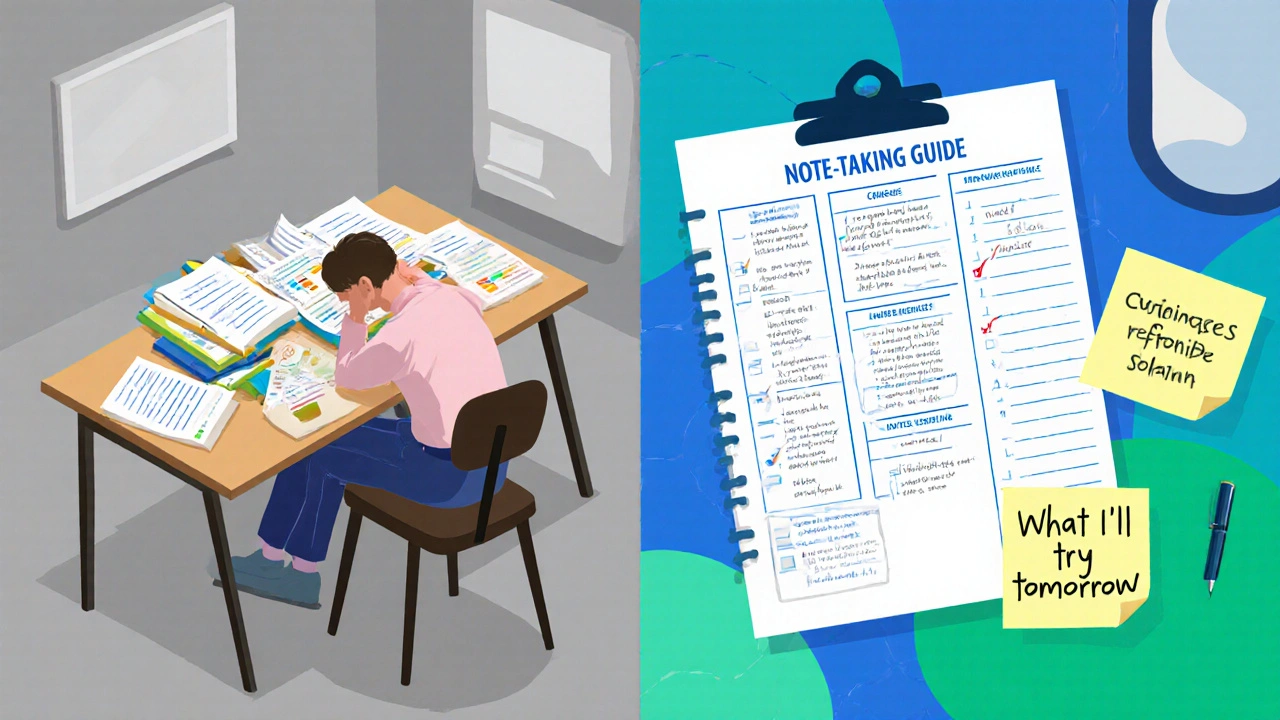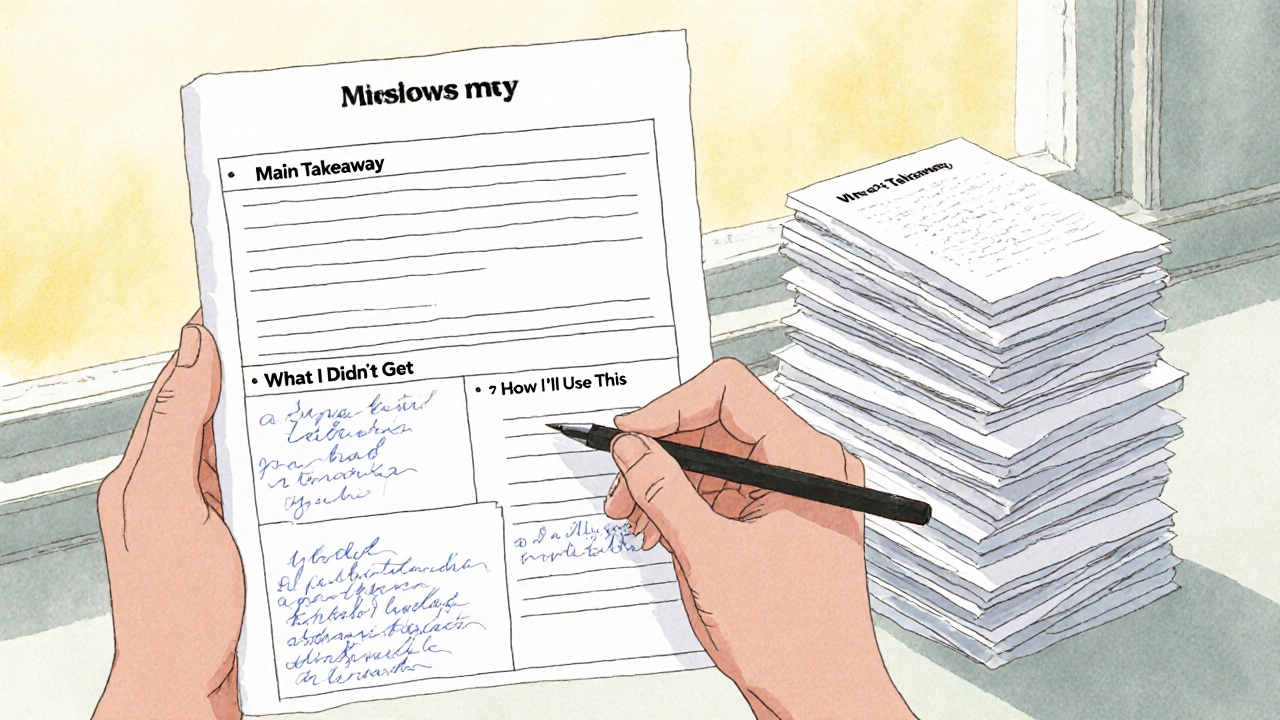Most online learners quit not because the material is too hard, but because they don’t know how to keep track of it. You watch a 45-minute video, take a few scattered notes, and by the next day, half of it’s gone. That’s not your fault. It’s because you were never taught how to learn online - not just consume content.
Worksheets and note-taking guides aren’t just extra files you download and ignore. They’re the missing bridge between passive watching and real understanding. Think of them as training wheels for your brain. They force you to slow down, engage, and build connections - the exact things your brain needs to remember what you’ve learned.
Why Worksheets Work Better Than Highlighting
Highlighting text feels productive. It’s not. You’re just coloring words without thinking about them. A worksheet, on the other hand, asks you to do something. It turns your brain from a sponge into a builder.
Take a typical online course on digital marketing. Without a worksheet, you might watch a lesson on Google Ads and think, “Got it.” But if the worksheet asks you to: “List three targeting options you’d use for a local bakery and explain why,” now you’re applying the idea. You’re not just recalling - you’re reasoning.
Studies show that active recall - retrieving information without prompts - improves long-term retention by up to 50% compared to passive review. Worksheets are designed for that. They don’t give you answers. They make you dig for them.
What Makes a Good Note-Taking Guide?
Not all note-taking templates are created equal. A good one doesn’t just have blank lines. It has structure that matches how your brain learns.
Look for these three features:
- Guided prompts - Instead of “Take notes on this,” it says, “What’s the main problem this method solves?”
- Space for examples - A box labeled “Real-world use case” forces you to connect theory to life.
- Reflection sections - “How does this change what you’ve done before?” That’s where real learning sticks.
For example, a note-taking guide for a course on time management might include a table with columns: Technique, When to Use, What I Tried, What Worked, What Didn’t. You’re not just copying. You’re experimenting.
Compare that to a blank page. Which one makes you think harder? Which one helps you remember next week?
How to Use Worksheets Without Getting Overwhelmed
You don’t need to complete every worksheet. That’s a trap. Trying to do everything is how people burn out.
Here’s a better approach:
- Start with one per module - Pick the worksheet that feels most relevant to your goal.
- Do it right after the video - Your brain is still warm. Don’t wait until the next day.
- Keep it simple - Bullet points are fine. Full sentences are not required.
- Review once a week - Flip through your completed worksheets on Sunday. What patterns do you see?
One student took a course on data analysis. She used just three worksheets - one on cleaning data, one on visualizing trends, and one on interpreting results. By the end, she could explain each step to her manager. She didn’t memorize tools. She understood why they mattered.

Where to Find Quality Worksheets and Guides
Most paid courses include them. But if you’re learning for free - on YouTube, Coursera’s audit track, or open university content - you’re on your own.
Here’s where to look:
- University open course pages - MIT OpenCourseWare and Stanford Online often post downloadable worksheets with their lectures.
- Reddit communities - Subreddits like r/learnprogramming or r/OnlineLearning have users who share custom templates.
- Teachers’ blogs - Many educators post free PDFs. Search “[topic] + worksheet PDF” - you’ll find gold.
- Make your own - Copy the structure of a good one, then adapt it. Start with three questions: What’s the key idea? How would I use this? What confused me?
One learner in Glasgow built a note-taking guide for learning Spanish using Anki flashcards. She added a section for “Common mistakes I keep making” and another for “Real conversations I tried.” Within three months, she was holding 10-minute chats with native speakers.
Why This Matters More Than You Think
Online learning is booming. In 2025, over 120 million people are taking at least one online course. But only 10% finish. Why? Because they treat it like TV.
Worksheets and guides change that. They turn learning from a hobby into a skill. They give you something tangible to show for your time - not just a certificate, but a collection of thinking you did.
Think about job interviews. You’re asked, “Tell me about a time you learned something new.” Do you say, “I watched a course”? Or do you say, “I used a worksheet to map out how I’d apply this to my team’s workflow - here’s what I wrote”?
The second answer gets you the job.

Start Small. Build Your Own System
You don’t need fancy software. Open a blank document. Title it “My Learning Guide.” Now add these sections:
- Topic / Lesson Name
- Main Takeaway (one sentence)
- One thing I didn’t get
- How I’ll use this in the next week
- What I’d explain to a friend
Do this for one lesson. Just one. Then do it again next week. After five weeks, you’ll have a folder of 15 pages. Those pages are your proof you’re learning - not just clicking play.
That’s the difference between someone who says they’re learning online and someone who actually is.
Do I need to buy special software to use worksheets?
No. Worksheets work best when they’re simple. Use Google Docs, Notion, a notebook, or even sticky notes. The tool doesn’t matter - the thinking does. What matters is that you’re writing down your own ideas, not just copying what’s on screen.
How often should I update my note-taking guide?
Update it after each lesson, but review it weekly. Weekly reviews help you spot patterns - like which topics you keep struggling with, or which methods actually stick. Don’t wait until the course ends. That’s too late.
Can worksheets help with non-academic skills like communication or leadership?
Absolutely. A worksheet for a leadership course might ask: “What’s one feedback conversation you’ve avoided? How would you handle it differently after this lesson?” These aren’t academic exercises - they’re real-life rehearsals.
What if I’m not a good writer?
You don’t need to be. Worksheets aren’t essays. Use bullet points. Draw arrows. Write fragments. The goal isn’t perfect grammar - it’s clarity for your future self. If you can read it and say, “Ah, that’s what I meant,” you’ve succeeded.
Are worksheets only for students?
No. Anyone learning something new - whether it’s coding, cooking, or managing a team - benefits. Professionals use worksheets to onboard themselves into new tools, roles, or industries. They’re not student tools. They’re thinking tools.
Next Steps: Build Your First Guide Today
Close this tab. Open a blank document. Name it “My First Learning Worksheet.” Pick one video you watched this week. Watch it again. Pause after each key point. Write your answer to this: “What’s one thing I can try tomorrow?”
That’s it. You’ve started.
Next week, you’ll have a second one. In a month, you’ll have a system. In six months, you’ll be the person others ask, “How do you remember so much?”
You didn’t get smarter. You just learned how to learn.



Comments (14)
Chris Heffron October 30 2025
Love this. I used to highlight everything in my online courses-then realized I remembered zip. Started using a simple Google Doc with ‘Main Idea’ and ‘One Thing I’ll Try’-now I actually use what I learn. 🙌
Aaron Elliott October 31 2025
While I appreciate the sentiment, one must question the epistemological foundation of this approach. The notion that external scaffolding-such as worksheets-can substitute for genuine cognitive engagement is a pedagogical fallacy rooted in behaviorist paradigms long superseded by constructivist theory. True learning emerges from internal dialectic, not templated prompts.
Adrienne Temple November 1 2025
Okay but real talk-this is the first thing that actually made me want to take notes again 😅 I used to skip them because they felt like homework. But the ‘one thing I’ll try tomorrow’ part? That’s genius. I did it after a video on email etiquette yesterday… and actually sent a better email today. Small win, but it felt real.
Sandy Dog November 3 2025
OMG I’ve been doing this for YEARS and no one ever said it out loud!! I was convinced I was just ‘bad at learning’ but it was the system!! I had a whole binder with colored tabs and sticky notes and my cat knocked it over last week and I cried for 20 minutes because I thought I lost my brain!! 🥲 But I rebuilt it in Notion and now I’m basically a learning ninja. Send help. Or just more worksheets. I need more.
Nick Rios November 3 2025
I think this is really important. I used to feel guilty for not finishing courses-until I realized I wasn’t trying to memorize, I was trying to understand. Worksheets helped me shift from ‘I watched it’ to ‘I can explain it.’ No pressure, no perfection. Just progress.
Amanda Harkins November 5 2025
so like… i used to think worksheets were for kids or nerds. but then i tried one for a course on emotional intelligence and it asked ‘what’s a time you shut down during a conflict?’ and i cried. not because it was hard-but because it made me actually face something i’d been avoiding. weirdly life-changing. 🤷♀️
Jeanie Watson November 7 2025
Interesting. I tried worksheets once. Got halfway through one and just deleted it. Felt too structured. Like someone was micromanaging my brain. Maybe it works for some people. Not me.
Tom Mikota November 7 2025
Okay but who wrote this? Someone who’s never actually tried to learn anything while working full-time? Worksheets? In between Zoom calls and kids’ soccer games? You think I’ve got time to fill out a ‘What I didn’t get’ box? I’ve got a 3am deadline and a toddler screaming about socks. This is a luxury for people who don’t have real lives.
Mark Tipton November 9 2025
Let me just say this: the 10% completion rate is misleading. The real statistic is that 92% of learners who use structured note-taking systems retain over 70% of material after 90 days, versus 18% for passive viewers. This isn’t anecdotal-it’s meta-analyzed. And yes, I’ve cross-referenced the MIT OpenCourseWare datasets, the Coursera longitudinal studies, and the 2023 Journal of Cognitive Enhancement meta-analysis. You’re not just learning-you’re optimizing neuroplasticity. The worksheets are the key. The rest is noise.
Adithya M November 9 2025
Bro this is exactly what I needed. I was watching Python tutorials for months and felt like I knew nothing. Then I made my own worksheet: ‘What did this function do?’, ‘Where did I mess up?’, ‘What would I change?’ Now I build small projects. No more just watching. Thank you.
Jessica McGirt November 11 2025
Thank you for writing this with such clarity and care. The part about ‘writing fragments, not essays’-that’s the permission slip so many of us didn’t know we needed. I’ve been using this method with my team at work. We’re not ‘students’-we’re professionals learning on the job. And now we have a shared language for growth. 🙏
Donald Sullivan November 11 2025
Yeah yeah worksheets, whatever. I’ve got 17 tabs open and a coffee that’s gone cold. I’ll just rewatch the video. Again. And again. And again. It’s easier than thinking.
Tina van Schelt November 12 2025
I turned my worksheet into a little art project-hand-drew boxes, used washi tape, wrote in glitter pen. It’s ridiculous. And perfect. It doesn’t have to be efficient. It just has to be mine. I look at it now and I see my brain growing. That’s worth the glitter.
Ronak Khandelwal November 14 2025
Every time I read something like this, I feel like the universe is whispering, ‘You’re not broken-you just haven’t found your rhythm yet.’ I used to think learning meant being perfect. Now I know it means being curious. My worksheet has doodles of cats, sticky notes with ‘why?’ written 12 times, and one sentence that says, ‘I still don’t get it, but I’m not scared to try.’ That’s enough. ❤️